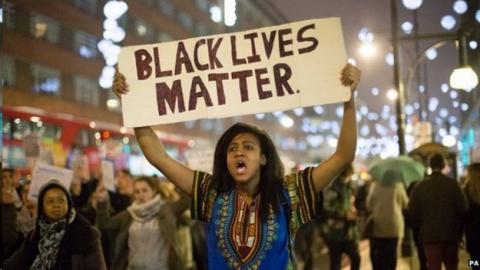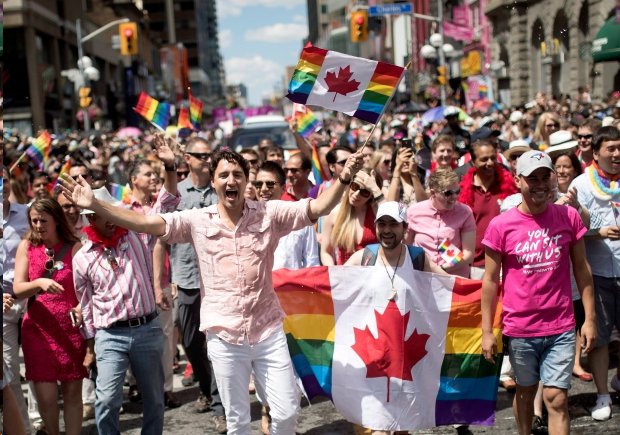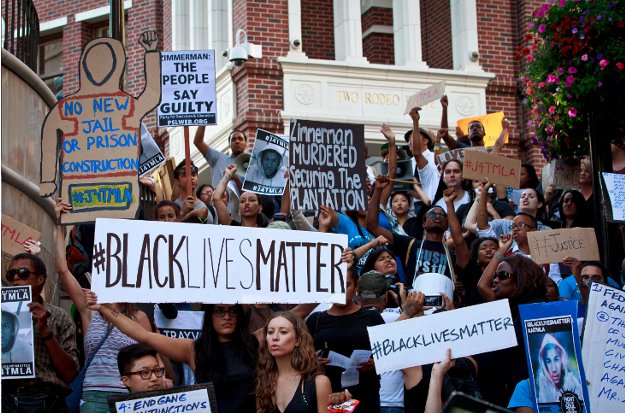The Pride of Black Lives Matter

On July 3, 2016, during Toronto’s Pride parade, Black Live Matters activists staged a sit-in. It effectively halted the parade, which serves as the grand finale of Toronto’s Pride month, for nearly 30 minutes. It was only after the parade’s organizers signed a list of demands drafted by BLM that the parade was allowed to continue. The demands included things such as more inclusivity and spaces for Black LGBT+ persons and, among other things, the removal of police floats and booths in all Pride community spaces.
The incident was a sharp reminder of the often-tumultuous relationship between the two marginalized groups, namely the Black and the LGBT+ communities. A lot has been said about the similarities between the civil rights and the gay rights movements, just as much as these comparisons have been decried. And while there has arguably been exponential progress in both movements, there remains a group that continues to endure the shortcomings of both: the activists who staged the sit-in at the Toronto Pride did so for and on behalf of queer Blacks.
The BLM Toronto chapter had been given the status of “Honored Group” for the parade. At first, BLM Toronto had its doubts about its involvement in the event, but when it realized that it would be a great opportunity to address anti-blackness within an already marginalized community, the group decided to accept the position as guest of honor. Subsequently, Pride organizers resented that they weren’t at least given a warning that the sit-in would be taking place.
The civil rights and the gay rights movements are no strangers to this strained, elastic relationship. It dates back to what is perhaps one of the most controversial and unbridled partnerships, certainly between the two movements, over half a century ago when the Black Panthers and the Gay Liberation Front found a combined effort in their fight for equality.
The Gay Liberation Front was founded as a direct result of the Stonewall Riots of 1969; its radical approach to protest and strategizing was a drastic adjustment to earlier homophile organizations, most notably Mattachine Society (the term “homophile” was the preferred term of the gay rights movement of the 50s through the 70s because it focused on same-sex love [-phile, from the Greek] rather than sexual conduct).
Mattachine Society had been founded in 1950 in Los Angeles and is considered one of the earliest American homophile organizations, perhaps second only to Chicago’s Society for Human Rights (another early organization, the Veterans Benevolent Association founded in 1945, focused exclusively on the treatment of homosexual veterans of the United States armed forces who had been less-than-dishonorably discharged and thus forewent the rights afforded to veterans).
Mattachine’s founder, Harry Hay, was a communist with arguably radical ideas who is widely regarded as drafting the first call-to-arms for a gay rights movement back in 1948 – his input and work was so instrumental that Hay is now often described as the founder of the modern gay movement.
Soon after, other organizations cropped up including the Daughters of Bilitis in 1955, an organization that fought for rights and equality for lesbians. For years, Mattachine Society, through its chapters across the country, provided a safe space for homosexuals as well as forums for a myriad of medical and legal experts who were sympathetic to the homosexual movement. In California, Mattachine Society successfully argued in court on behalf of a man who openly admitted to being a gay in front of a jury, and Dale Jennings became the first homosexual to be exonerated of a “vag-lewd” charge in the state – vag-lewd, as “lewd vagrancy” became colloquially known, was the single most popular charge for homosexuals who were arrested by the vice squads during this time. By 1965, under the leadership of the militant Frank Kameny, the Mattachine Society Chapter of Washington DC publicly picketed the White House in the first LGBT+ protest of its kind at the seat of the American government.

But even with its record, by the mid-60s Mattachine Society had become, in the eyes of some, too soft. Hay had been effectively run out of the organization, which had shifted its focus to present homosexuals as respectable members of society and urged homosexuals to come out to upend the misconceptions placed upon them. This was a sharp contrast to Hay’s notion of “fairy culture” that resisted the idea that homosexuals were not at all different from heterosexuals.
Hay disdained to his death in 2002, the “assimilationist” goals of the subsequent leadership of Mattachine Society, and lamented that nothing of value in the gay rights movement was seen again until the late 60s when the Stonewall Riots sparked the formation of the Gay Liberation Front. The Gay Liberation Front was formed, to some extent, as a radical option to a Mattachine Society that had become insipid and complacent in the views of many; similarly, the Lavender Menace was an unofficial lesbian rights group formed in 1970 as a response to the exclusion of lesbian rights in the feminist movement of the decade, which frowned upon the intersectionality of women’s and lesbians’ rights.
The Gay Liberation Front was founded entirely within the New York chapter of Mattachine Society. It was never clear when it became completely detached from its parent organization, though it is widely believed that it was when the Gay Liberation Front publicly announced its support for a Black Panthers’ rally at the Woman’s House of Detention and Dick Lietsch, the president of Mattachine New York, fervently objected the sponsorship. Shortly after, towards the end of 1969, the Gay Liberation Front would donate $500 (approx. $3,400 today; rent for a newly-designated rent-controlled apartment in Hell’s Kitchen was about $75 at the time) to the Black Panthers Party as a showcase of support to the organization after which they were heavily modeled. This stunt was not well received by many. Only a few days later, dissidents derided the Gay Liberation Front and went on to form the Gay Activists Alliance.
Meanwhile, by August of 1970, the controversial founder of the Black Panthers, Huey Newton, declared his support for the women liberation and gay liberation movements in a speech he delivered in New York. Just after a year of the Stonewall Riots, Newton addressed his party on the intersectionality of racism, sexism, and homophobia. It may be safe to say that some members of the audience may not have readily accepted this message. Angela Davis spoke about how queer liberation must become part of the Black Panthers’ mission. She recalled Newton’s speech that the Panthers must unite with the gay and women liberation movements “in a revolutionary fashion” even though everyone’s first instinct is to “want to hit a homosexual in the mouth and want a woman to be quiet.”
The Gay Activists Alliance would remain in operation until 1981, staging raucous zaps widely covered by the media that put gay rights in the limelight. It affiliated the Greek letter lambda as an international gay rights icon when it was selected to be the symbol of its New York chapter. But the Gay Liberation Front was fleeting. Fraught by internal division as whether to focus the group’s activism into gay rights or tackle a wider field of political issues, it effectively ceased to operate by 1972, only three years into existence.
What the abridged history outlined above elucidates is that the relationship between these two marginalized groups, Blacks and LGBT+, has historically been charged. In response to the more militant, short-lived Gay Liberation Front, the Gay Activists Alliance was founded partly because of the public patronage of the Black Panthers and because its member wanted to prioritize issues that were directly affecting homosexuals. But what these early organizations perhaps failed to acknowledge or realize is what Angela Davis and Huey Newton saw as early opportunities for broader social equality. It may be hard to imagine the Black Panthers and the Gay Liberation Front working towards a common goal, two organizations that fit so uncomfortably with each other. But that common goal for equality is sharpened by the unequivocal fact that there exists Black LGBT+ persons. Caught between these two movements seemingly at odds with each other, queer people of color must struggle at both ends of this spectrum.
In the modern political climate, this divide between the Black and the LGBT+ community is still evident. One often-cited derision of the comparison between the gay rights movement and the civil rights movement is that the former ignores the acute suffering and treatment of Blacks in American history and its unique depth of brutality and injustice. The most common contention is that, while certainly not ideal, a white homosexual can hide being gay, while a black woman cannot hide her blackness.
On the other hand, the LGBT+ community cites the unleveled quid pro quo between the two movements, such as the assertion that African-Americans were the culprits of the passing of Proposition 8, which banned gay marriage in California. Exit polls showed that as many as 70 percent of African-American Californians voted in favor of Proposition 8. More in-depth studies have since shown that religion, more so than race, was a better indicative of constituents voting for or against the legislation; the study stipulated that African-Americans, being the most religious group in California, accounted for approximately 58 percent of the votes in favor of Proposition 8, while Latin-Americans almost paralleled that with 59 percent voting in favor of it. Amidst this, pundits have denounced the scapegoating of Blacks on the passage of Proposition 8.

This is an interesting outlook because it is one that BLM strongly opposes. In other words, BLM is an organization that seeks to represent all Blacks from all walks of life. This is a stance that many support, especially given the volatility of the relationship between Blacks and the police and the indisputably similar rapport between the LGBT+ community and the police.
In short, the argument is that one cannot be pro-black and also anti-gay, the basic premise being that it is ineffectual and, to some extent, iniquitous for one marginalized group to challenge the progress made by another marginalized group.
This is the same sentiment that BLM attempted to send when it sabotaged the Toronto Pride parade. The sit-in, then, may have taken on a larger significance than a protest to demand more funding for Black queer spaces. It called on BLM’s deeply held belief that one cannot be pro-LGBT+ but also anti-Black. In its list of demands, the exclusion of police participation in Pride events was arguably the most scorned. But while the petition can be easily considered explosive and even unfair, it has always been a concern in the planning of Pride festivities. A month earlier, the BLM Chapter of the Bay Area had withdrawn from the San Francisco Pride parade due to increased police presence. And even the organizers of Toronto Pride realized the difficulty of balancing the need for security and the celebrators actually feeling safe. They actually sought to increase security but not the number of uniformed officers, and the police understood that concern.
Supporters of the BLM causes were quick to point out that Pride, and specifically Pride parades, were born from protests against police brutality during the Stonewall Riots and the LGBT+ community should do well to remember that; on the other hand, detractors argued that the progress made in the relationship between the police and the LGBT+ community and Pride’s spirit of inclusivity should take precedence.
But perhaps the volatile relationship between the police and the LGBT+ community, inclusive or not, is beside the point. The Pride celebrations of 2016 in North America were mired by the recent mass shooting of the Pulse dance club in Orlando. This was the main reason that Pride festivities thought it necessary to increase police presence. Maybe it is precisely because this tragedy had taken place in a gay club frequented by Latin LGBT+ that BLM saw the need to call for more safe spaces.
The slaughter of a subculture within an already marginalized group demanded that the conversation tilt towards the struggles of being part of two ostracized groups in America. In the simplest terms, queer people of color did not feel safe with increased police presence, a challenge that Pride organizers were aware of. And inclusivity, while of paramount importance, can be exponentially limited if some of the more sidelined members feel even more excluded. After all, gender and sexual diversity does not negate the reality of blackness.
Author Bio:
Angelo Franco is Highbrow Magazine’s chief features writer.
For Highbrow Magazine




























































































































































































































































































































